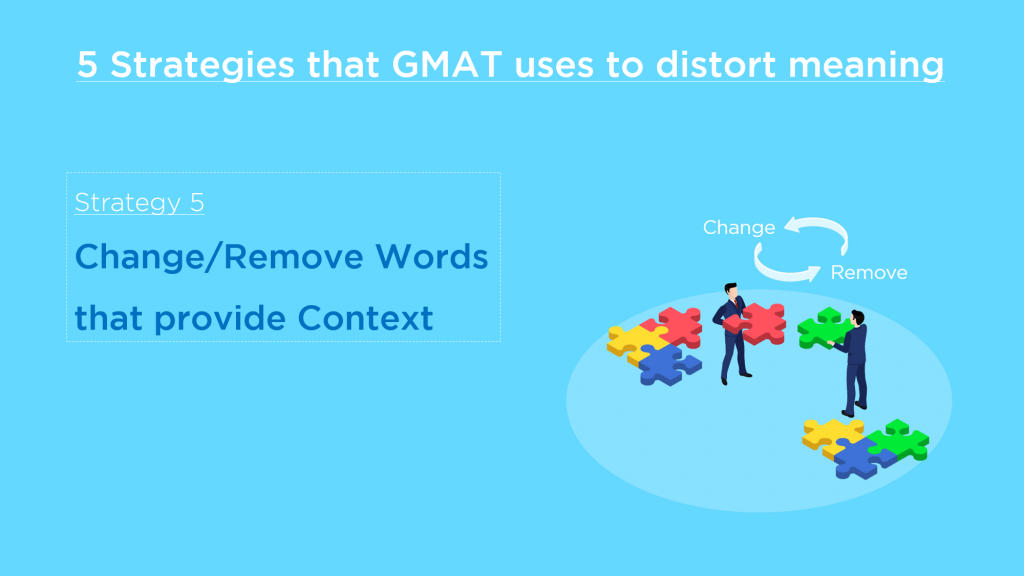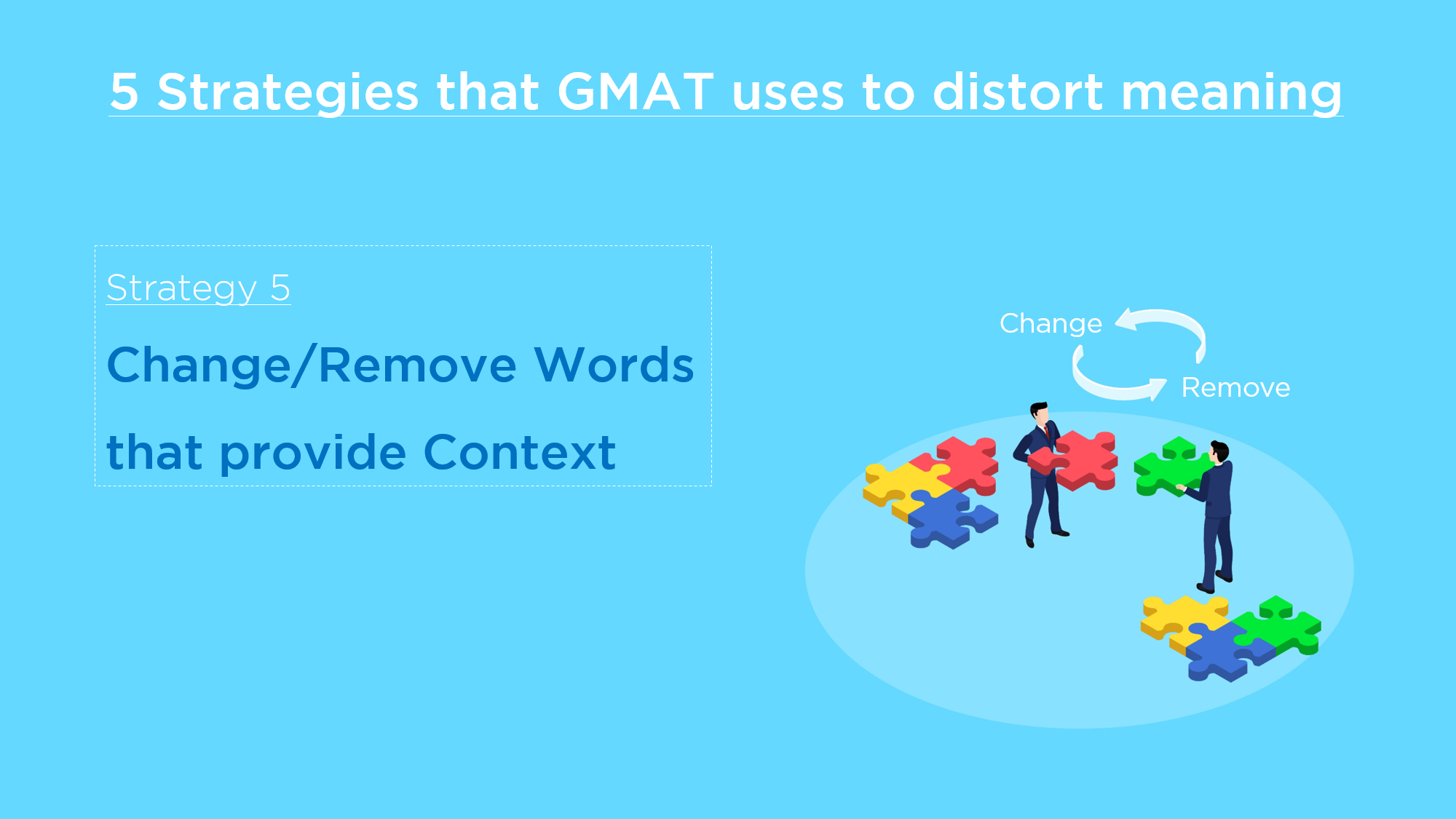This article is the last in the series of “5 Strategies that GMAT uses to distort meaning“. In the previous article, we had discussed the first strategy – “Change of Voice“. In this one, we’ll be discussing the last strategy – “Change/Remove Words that provide Context”, along with official questions and explanations.

The links for the other articles in this series are provided at the end of this article.
Strategy 5 – Change/remove words that provide context
How does GMAC use this strategy: There are several context important words in the English language. An answer choice may either add or remove such contextually important words. Since these words provide context, any such change can result in a change in the meaning of the sentence.
Let’s take a simple example below:
Simple example
- Amy has evolved into an exceptionally talented actress.
- Amy is an exceptionally talented actress.
Both sentences above are grammatically correct. Both use similar words but the slight difference in the choice of words results in the change of meaning of the sentence. Sentence 1 shows the evolution of Amy into a talented actress. This sentence implies that may be Amy was not such a great actress when she began her career. But now she is evolved into one. However, note that sentence 1 omits all this information. All it states is the fact that is current now – Amy is a talented actress. The evolution part is completed omitted. And hence by removing contextually important words, the meaning has been changed.
This is exactly how GMAT may introduce a difference in meaning. Thus, you should always read the original sentence carefully and then determine all the information provided in the choice. And then you should select the choice that communicates all that information in grammatically correct manner.
Let’s take another set of sentences:
- Tom may go to gym in the evening.
- Use of “may” denotes possibility. It implies that Tom may or may not go to the gym. He has not as yet decided and he may make the decision at the last minute.
- Tom will go to gym in the evening.
- Use of “will” denotes certainty. This sentence implies that Tom is determined to go to the gym. He will definitely go to the gym this evening.
- Tom can go to the gym in the evening.
- Use of “can” shows capability. This sentence implies that circumstances are such that Tom can go to the gym – may be he has completed his work and now has the time to go to the gym or may be he has a baby at home and he has been able to make the necessary arrangements.
So notice how just by changing the helping verb – may, will, can – the meaning could be changed so drastically.
Official Question 1 – OG Verbal Review 2 – Q#43
Now let’s take an official question:
Though the term “graphic design” may suggest laying out corporate brochures and annual reports, they have come to signify widely ranging work, from package designs and company logotypes to signs, book jackets, computer graphics, and film titles.
- suggest laying out corporate brochures and annual reports, they have come to signify widely ranging
- suggest laying out corporate brochures and annual reports, it has come to signify a wide range of
- suggest corporate brochure and annual report layout, it has signified widely ranging
- have suggested corporate brochure and annual report layout, it has signified a wide range of
- have suggested laying out corporate brochures and annual reports, they have come to signify widely ranging
Intended meaning from Choice A: This choice indicates that even though “graphic design” was designed to a certain set of tasks, it has come to serve a wide range of tasks. The sentence provides this list of wide range of activities. It is important to note that the choice indicates that “graphic design” has come to serve this wide range of activities.
Correct: Choice B corrects the pronoun number disagreement error and communicates the logical intended meaning of choice A clearly.
Grammatically Correct but Incorrect choice (D) – This choice removes the contextually important term – “has come to” (or evolved). This choice now implies that even though “graphic design” may have been designed to serve purpose X, it actually serves purpose Y. This is a completely different meaning than what is presented by choices A and B. Note the difference once again in the simplified structure.
- Choice A (and Correct choice B) – Though X may be designed to do X, it has come to do Y.
- Choice D – Though X may have been designed to do X, it does Y.
Official Question 2 – OG Verbal Review 2 – Q#52
Recently discovered fossil remains strongly suggest that the Australian egg-laying mammals of today are a branch of the main stem of mammalian evolution rather than developing independently from a common ancestor of mammals more than 220 million years ago.
- rather than developing independently from
- rather than a type that developed independently from
- rather than a type whose developments was independent of
- instead of developing independently from
- instead of a development that was independent of
Intended meaning from Choice A: Per choice A, Australian egg-laying mammals were not developed independently from a common ancestor. Also, as stated in the non-underlined portion, they are a branch of the main stem of evolution.
Grammatically Correct but Incorrect choice (C) – Per choice C, these mammals were not of the kind whose development was independent of a common ancestor. This is different from saying that these mammals were not developed independently from a common ancestor.
The difference in meaning can be exemplified by the following set of sentences:
- Like choice A – Company ABC has developed independently from its parent organization XYZ.
- This implies that company ABC has developed from its parent organization. But it has done so independently without any extra outside assistance.
- Like choice D – Development of company ABC is independent of its parent organization XYZ.
- This implies that company ABC development has nothing to do with its parent organization
How to evaluate choices that change the meaning?
- Understand the logical meaning of the original choice.
- Look for the answer choice that best communicates the same meaning in un-ambiguous and grammatically correct manner.
- Ignore choices that may be grammatically correct but change the meaning or the emphasis in the sentence. Pay close attention to choices that change the contextually important words.
Exercise Sentences
Example 1 – Logitech Success
Although Logitech’s recent press release credits its success to the innovation in its product division, its future success hinges on how closely its products are related to those of Apple’s.
- how closely its products are related to those of Apple’s
- its close relationship with Apple
- on the relationship between its products and Apple’s
- how closely it is related to Apple
- how closely its products are related to Apple’s
Understand the Meaning of the Original Sentence
The sentence presents a disparity or a contrast. It states a fact that Logitech credits its success to the innovation in its product division. Then it states that the future success of Logitech depends on some other factor – how closely its products are related to Apple’s products.
Find the Errors in the Original Sentence
- Although Logitech’s recent press release credits its success to the innovation in its product division,
- its future success hinges on
- how closely its products are related to those of Apple’s.
All SV pairs are accounted for and agree in number. The verb tenses have been used appropriately. The comparison is not stated correctly. Logitech’s products have been compared to products of Apple’s products. Note that “Apple’s” implies “Apple’s products”. “those” also logically refer to “products”. This results in distortion of the intended comparison. Either “Apple’s” should be made “Apple” or “those” should be removed.
Review Answer choices to do POE
Choice B – Grammatically Correct but Incorrect Choice – This choice completely changes the intended meaning. This choice states that success depends on the relationship between the two companies. This is different from the intended meaning – how closely aligned the products of the two companies are.
Choice C – Grammatically Correct but Incorrect Choice – This choice removes the contextually important word – “closely”. Now the choice states that the success hinges on the “relationship” between the products instead of the “extent of close relation” between the products.
Choice D – Grammatically Correct but Incorrect Choice – This choice completely distorts the intended meaning since it no longer talks about the close alignment of the products of the two companies. It talks about the close alignment of the companies themselves.
Choice E – Correct Choice.
Takeaways
It is very important to understand the intended meaning of the sentence and then select the choice that communicates that intended meaning in grammatically correct manner.
Here’s a list of the articles in the complete series:
- 5 Strategies that GMAT uses to distort meaning – Part 1 – Modifiers (Update 2018)
- GMAT and Meaning – Part 2: Strategy 2 – Use of Modifiers
- GMAT and Meaning – Part 3: Strategy 3 – Change of Conjunctions
- GMAT and Meaning – Part 4: Strategy 4 – Change of Voice
- GMAT and Meaning – Part 5 – Change/Remove Words that provide Context
If you are planning to take the GMAT, we can help you with a personalized study plan and give you access to quality online content to prepare. Write to us at acethegmat@e-gmat.com. We are the most reviewed GMAT prep company on gmatclub with more than 2400 reviews and are the only prep company that has delivered more than 700+ scores than any other GMAT club partner. Why don’t you take a free trial and judge for yourself?













